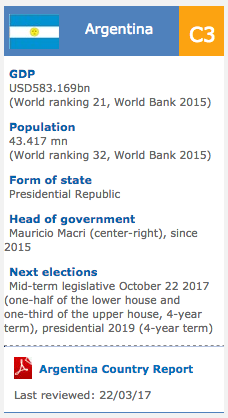Zambia: Zambia Outlook for 2013-17
2015/01/27

The country (Zambia) is situated in Southern Africa, east of Angola.
It has borders with Congo (Kinshasa) for 1930 km, Angola for 1110 km, Malawi for 837 km, Mozambique for 419km, Namibia for 233km, Tanzania for 338 km and Zimbabwe for 797 km. Land in Zambia is frequently high plateau with a number of hills and mountains.
Zambian land covers an area of 752614 km²
The climate is tropical; modified by altitude; rainy season (October to April).
Zambian speak English, major vernaculars - Kaonda,Bemba, Lozi, Lunda, Nyanja, Tonga,Luvale, and about 70 other indigenous languages.
OVERVIEW
The president, Michael Sata, and his party, the Patriotic Front (PF), will remain in power at least until the next elections in 2016. The government will focus on boosting mining revenue, supporting local investment and lowering unemployment. It will remain willing to intervene directly in the economy in pursuit of these goals. The fiscal deficit is forecast to narrow in 2014-15 as the government restricts spending growth to keep the debt stock in check. We forecast real GDP growth of 6.8% in 2013 as maize and copper output recover, an average of 8.1% in 2014-16 as various large mining projects come on stream, and 5.5% in 2017 as the copper boom winds down. Services and manufacturing are expected to grow robustly throughout 2013-17. Our forecasts allow for some delays in ongoing copper projects, and growth will be higher if they are completed on time. It would be lower than forecast in the event of drought, a slump in copper prices or a major deterioration in the policy agenda.
Political outlook
The government's decision to scrap fuel and fertiliser subsidies will further weigh on its public support base.
Economic policy outlook
From the 2013/14 growing season, the government will discontinue fertiliser subsidies and minimum price guarantees for small-scale producers of maize. The two policies have contributed to a surge in domestic maize production but have nevertheless been deeply flawed. The changes are therefore warranted, but the short-term costs will be high.
Economic forecast
Our fiscal deficit forecasts for 2013 and 2014 have declined marginally following the government's decision to get rid of fuel and fertiliser subsidies.
Our real GDP growth forecast for 2014 has been lowered from 8.4% to 8.1% owing to the impact of recent agricultural policy changes on the sector's growth. The forecast for 2016 has been raised from 7.9% to 8.2% owing to expectations of slightly higher pre-election fiscal spending.
Outlook for 2013-17
- Political stability will be maintained, but this will be marred by sporadic unrest as the government continues to antagonise the opposition and voters remain dissatisfied with its slow progress in meeting its campaign promises.
- Despite voter dissatisfaction, the president, Michael Sata, and the Patriotic Front (PF) will remain in power at least until the next elections, in 2016.
- The government will focus on boosting mining revenue, supporting local investment and reducing unemployment. However, it is prone to imprudent policy moves, which would undermine these goals.
- Real GDP growth is forecast to average 7.3% in 2013-17, supported by large investments in infrastructure and mines, a surge in copper production and robust growth in services and manufacturing.
- The kwacha is forecast to depreciate by an annual average of 3.6%, to an average of ZK6.14:US$1 in 2017, as strong growth in foreign investment and exports is offset by robust import demand and a strong US dollar.
- The current-account position is expected to deteriorate in 2013 as imports grow rapidly; to improve in 2014-16 as production of copper-the country's main export-rises sharply; and to weaken in 2017 as export growth slows.
Review
- The Supreme Court has ruled that the tribunal appointed last year by Mr Sata to investigate an alleged breach of the Judicial Code of Conduct by three high-ranking judges is legal.
- In a radical overhaul of its agricultural policies, the government has stated that it will stop subsidising fertiliser for small-scale producers of maize and will discontinue price subsidies on the staple in the current growing season.
- The two subsidy policies have underpinned a surge in domestic maize production, but have nevertheless been deeply flawed. The changes are therefore warranted, although the short-term costs will be high.
- The Energy Regulation Board's approval of a 21% increase in fuel prices has stoked inflation, sparking protests by university students against the govern‑ment's decision to eliminate the 5% fuel subsidy.
- Plans by Konkola Copper Mines-one of Zambia's largest copper producers-to lay off 2,000 workers (around 10% of its workforce) have highlighted the cost and price pressures facing the mining sector.
- The direct impact of any retrenchment on the Zambian economy would be limited-KCM does not plan to cut production or investment-but the indirect economic consequences and political implications would be significant.
- Related Articles

Africa's Relationship With China Is Ancient History
2017/07/02 In 2002 South Africa's Parliament unveiled a digital reproduction of a map - of China, the Middle East and Africa - that some speculated could be the initial map of the African continent. The Da Ming Hun Yi Tu - the Comprehensive Map of the Great Ming Empire - was drawn up around 1389 during the Ming Dynasty, according to historian Hyunhee Park.
Africa: Making Things Happen at the Bank - 'Not a Talk Shop' - Akin Adesina
2017/07/02 Dr. Akinwumi Adesina is focusing on five areas to achieve the African and world goals for a prosperous continent since becoming president of the African Development Bank - Africa's major public financial institution in September 2015. He was a keynote speaker at this month's Corporate Council on Africa's U.S.- Africa Business Summit in Washington D.C. and moderated a lively panel with five African government ministers. He as well received the Gene White Lifetime Succcess Award from the World Child Nutrition Foundation. This week, he was named the 2017 recipient of the World Food Prize, a prestigious honor that includes a $250,000 award. In an interview in Washington, DC, Adesina discussed the Development Bank's ambitious schedule and his vision for attracting the increase capital Africa needs. Posting questions for AllAfrica was Noluthando Crockett-Ntonga.
Climate change laws around the world
2017/05/14 There has been a 20-fold increase in the number of global climate change laws since 1997, according to the most comprehensive database of relevant policy and legislation. The database, produced by the Grantham Research Institute on Climate Change and the Environment and the Sabin Center on Climate Change Law, includes more than 1,200 relevant policies across 164 countries, which account for 95% of global greenhouse gas emissions.
Growing number of children surviving complicated births in low
2016/07/23 The number of children suffering from preventable blindness is increasing, half because additional children are surviving complicated births in low- and middle-gain nations, specialists say. Worldwide, about 19 million children under the age of 15 are blind, with 12 million of these cases preventable or treatable. Experts say one cause of high rates of blindness is retinopathy of prematurity (Rop), which occurs in premature infants and can be caused by being given too much oxygen next birth. Brian Doolan, CEO of the Fred Hollows Foundation, said world advances in neonatal care mean additional children are surviving early births, but this means additional premature babies are at risk of Rop.Added value in Zambian economy and win-win partnerships gain momentum
2015/11/08 Zambia’s government is targeting the diversification of its economy, particularly by boosting the agriculture and manufacturing sectors and adding price wherever possible, inclunding developing its infrastructure. Minister of Data Chishimba Kambwili discusses the opportunities and challenges ahead.
- Zambia News
-
- ZAMBIA: Zambia insists on fish import restriction despite deficit
- ZAMBIA: Zambian government hailed over move to increase tobacco taxes
- CHINA: Chinese-supported infrastructure projects change Zambia's landscape
- BOTSWANA: Africa: USA-Africa - No Policy? Bad Policy? or Both?
- BOTSWANA: Africa: U.S. State Department To Get Experienced Diplomat in Key Africa Post
- BOTSWANA: Africa’s economic growth in 2016 was driven by East Africa
- Trending Articles
-
- KENYA: Kenya to hold fresh presidential election on October 17
- HUNGARY: Hungary registers trade surplus of 5.4 bln euros in H1 2017
- KENYA: Kenya's overall inflation rate rises by 8 pct in August
- ZAMBIA: Zambia insists on fish import restriction despite deficit
- BOTSWANA: Africa: USA-Africa - No Policy? Bad Policy? or Both?
- KENYA: Political activities gather pace in Kenya after annulment of polls












